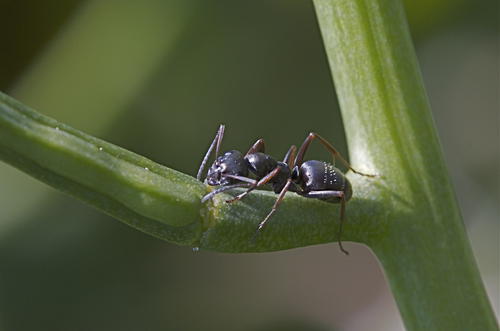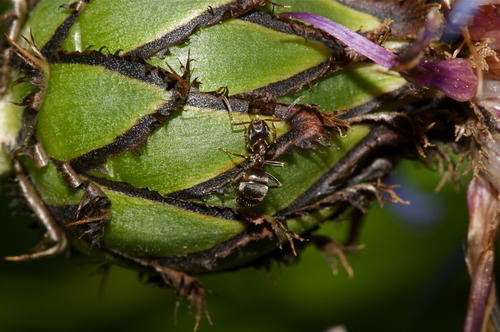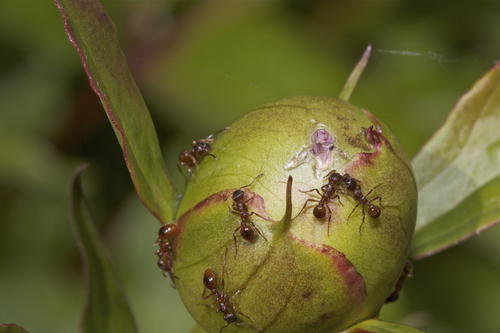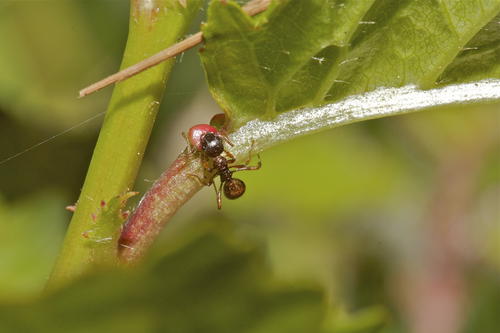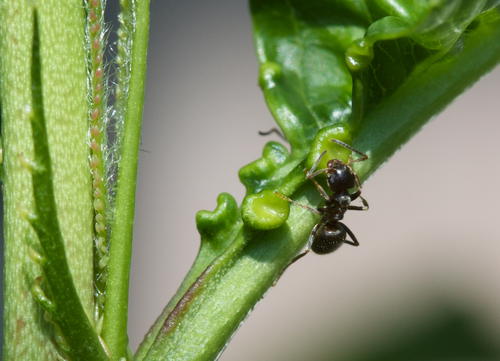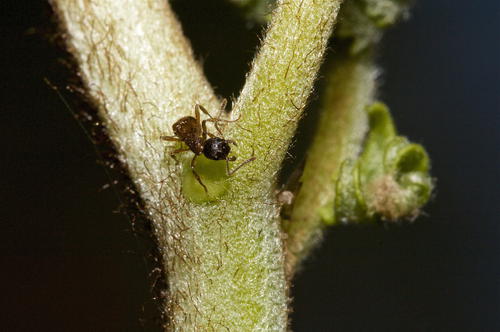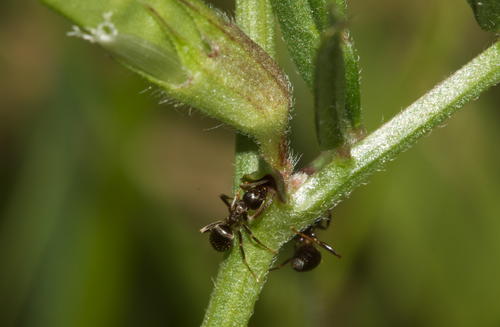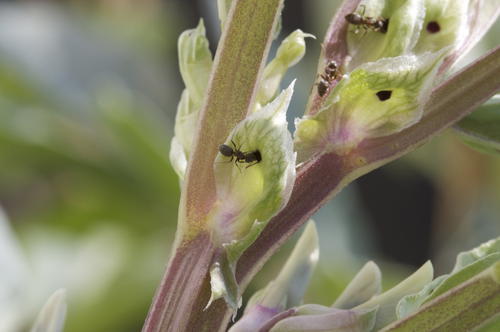Ants and Extra-floral Nectaries
Rosemary Winnall
We know that many plants produce nectar within their flowers to attract insect pollinators. However, some plants have extra-floral nectaries (EFNs) which are situated in parts of the plant outside the calyx. These are glands that produce water and sugars but they are not designed to attract and reward pollinators. The nectar produced by EFNs is sweeter than phloem and is made up of a mixture of glucose, fructose, sucrose and some protein, amino acids and organic acids.
These EFNs may be found on leaf margins, leaf axils, petioles, stipules, flower bracts, sepals and flower stalks. They may be conspicuous as raised glands or recessed basins and are sometimes coloured differently than the surrounding plant material.
Ants are often attracted to these to feed, as are occasionally other insects. The presence of the ants helps to protect the plant from browsing and from insects laying eggs on the foliage, and experiments have shown that plants with ants do better than plants without. Ants at nectaries on buds can protect the flower from nectar robbing.
Post-floral nectaries are found after the flower has died back and the fruits or seedpods are developing. The presence of ants in this situation help to protect the developing seeds from being eaten. So far I have seen this on Ivy and Garlic Mustard.
It is well known that ants visit aphids to feed on the honeydew that they excrete. So when ants are seen on plants, it is essential to check what they are doing. Are the ants feeding, and is so, are there aphids present or are nectaries involved?
I first noticed ants on extra-floral nectaries in a greenhouse where many Lasius niger ants were feeding on extra-floral nectaries on nectarines and peach plants. As these plants are Prunus species I quickly checked out the nearest Wild Cherry Prunus avium, and yes, ants were present there too! This stimulated some internet research and I found that although there has been dedicated work done in Florida, little has been recorded about EFNs from the UK. This started me looking more closely and documenting evidence. I photographed the ants feeding, identified the ant and the plant and started to keep a list of what I discovered. This is an ongoing project, but my results so far can be seen in the table 1. It is interesting to note that I have not to date found the common ant Formica fusca feeding in this way.
There are other plants noted for their EFNs, such as Elder Sambucus nigra , Dog’s Mercury Mercurialis perennis, willows Salix sp., Cherry Laurel Prunus laurocerasus, Acacia, Polygonum, Passiflora, Cucurbita, vines, Helianthus, Hibiscus, Robinia. I have yet to check these out. So there is plenty more work to be done in the search for ants using extra-floral nectaries in our gardens and countryside!
Plant | Lasius niger | Myrmica rubra | Myrmica ruginodis |
| Alliaria petiolata, Garlic Mustard |  | ||
| Centaurea sp. Garden Knapweed |  |  | |
| Fraxinus excelsior, Ash |  | ||
| Paeonia sp., Peony |  | ||
| Prunus armeniaca, Apricot |  | ||
| Prunus avium, Wild Cherry |  |  | |
| Prunus persica, Nectarine |  | ||
| Pteridium aquilinum, Bracken |  |  | |
| Vibernum opulus, Guelder Rose |  | ||
| Vicia sativa, Common Vetch |  |  |  |
| Vicia sepium, Bush Vetch |  |  | |
| Vicia faba, Broad Bean |  |
Table 1. Ant species found feeding on extra-floral nectaries.
Images
Fig. 1. Lasius niger on Garlic Mustard. Rosemary Winnall
Fig. 2. Lasius niger on Centaurea. Rosemary Winnall
Fig. 3. Myrmica rubra on Peony. Rosemary Winnall
Fig. 4. Myrmica ruginodis on Wild Cherry. Rosemary Winnall
Fig. 5. Lasius niger on Nectarine. Rosemary Winnall
Fig. 6. Myrmica rubra on bracken. Rosemary Winnall
Fig. 7. Lasius niger on Common Vetch. Rosemary Winnall
Fig. 8. Lasius niger on Broad Bean. Rosemary Winnall
